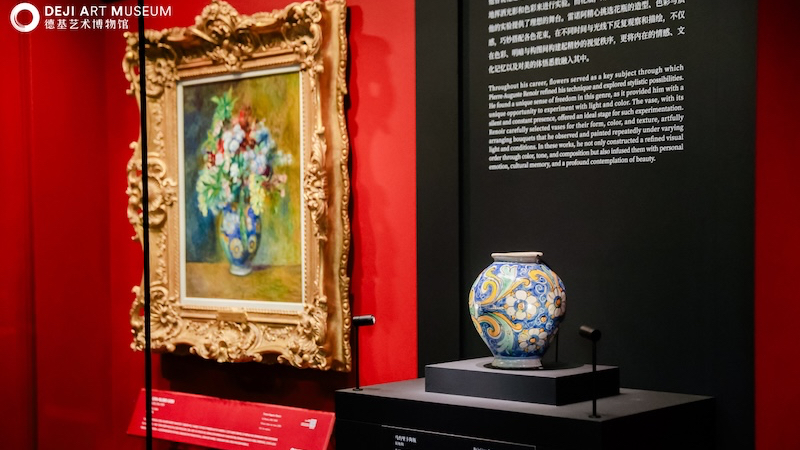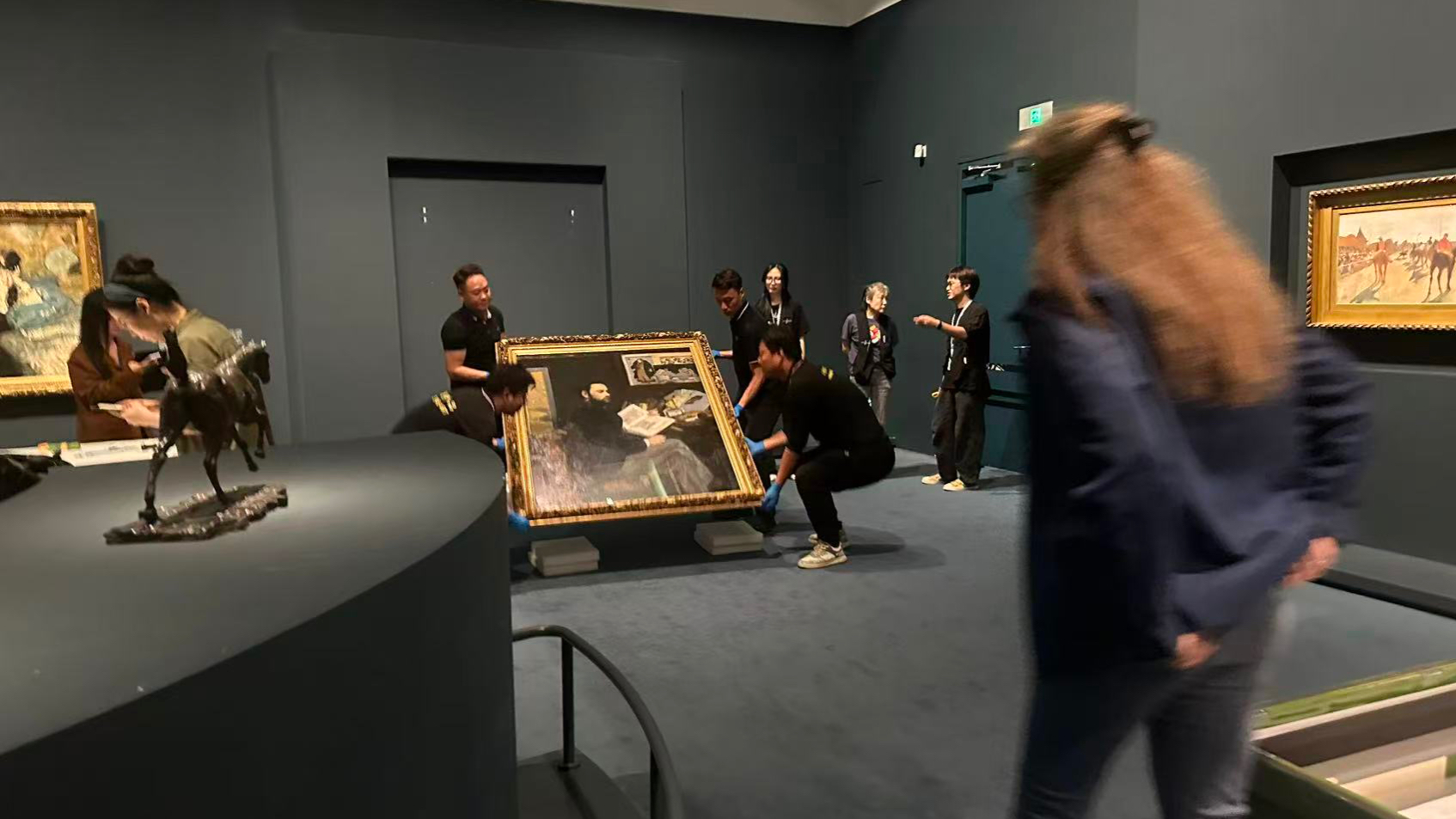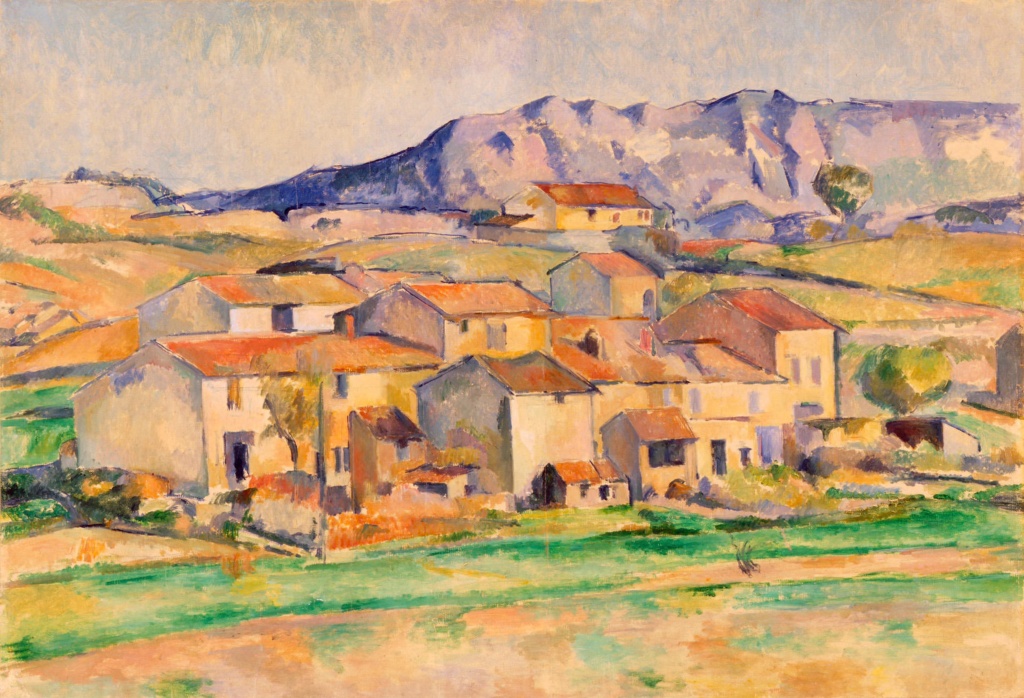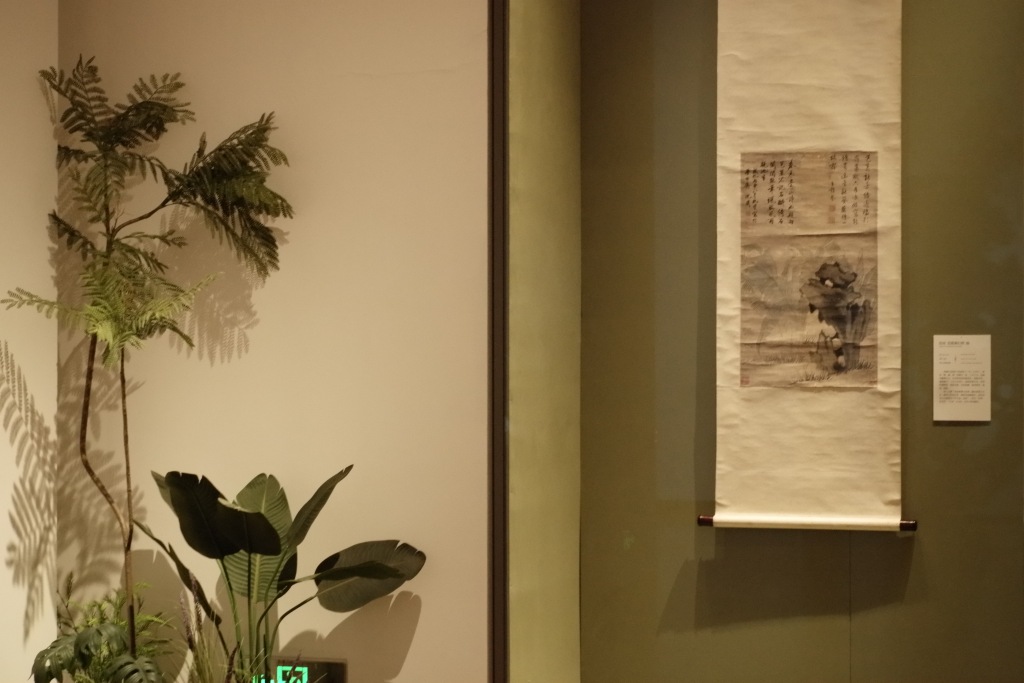

The Paper learned that the Nanjing Deji Art Museum's permanent exhibition of modern and contemporary art collection, "Endless Movement and Stillness: Masterpieces of Floral-Themed Art from the Museum's Collection," has recently reopened. The exhibition, based on the framework laid by the special curator Joaquin Pissarro, grandson of Impressionist painter Pissarro, was developed through the acquisition and research results of the past two years. The number of exhibits has increased to 140 pieces/sets, of which nearly one-third are new collections exhibited for the first time.
Among them, the Impressionist artist Renoir's "Flowers in a Vase" and the Majorica vase (formerly in the Renoir family's collection) acquired by the Deji Art Museum were unpacked and placed in a display case on October 23rd. The vase in "Flowers in a Vase" appears in at least six of Renoir's works, including "Girls at the Piano," now in the collection of the Metropolitan Museum of Art in New York. This cherished vase also witnessed the creation of many of his important works. A century later, the work and the vase are reunited in the exhibition hall.

At the exhibition "Endless Movement and Stillness: Masterpieces of Floral-Themed Art from the Museum's Collection", Renoir's "Flowers in a Vase" was displayed alongside the vase in the painting.
It is reported that "Endless Movement and Stillness: Masterpieces of Floral-Themed Art from the Museum's Collection" is the core permanent exhibition of the Deji Art Museum, which focuses on presenting floral-themed works in the museum's collection of modern and contemporary art history from China and abroad. Relying on the Deji Art Museum's more than ten years of research and collection practice in the field of flowers, the exhibition re-examines flowers and floral-themed art creations from a cross-cultural and interdisciplinary perspective, witnessing a broader historical picture and mutual learning between civilizations.
With this renovation, the exhibition's artist lineup has expanded to 109 artists/groups, including renowned modern masters such as Monet, Renoir, Cézanne, Munch, Picasso, and Matisse, as well as international contemporary artists such as Warhol, Yayoi Kusama, Hockney, Kiefer, Koons, and Yoshitomo Nara. The exhibition showcases pioneering Chinese artists studying abroad, including Sanyu, Pan Yuliang, Wu Dayu, Wu Guanzhong, Zao Wou-Ki, and Chu Teh-Chun, alongside renowned Chinese contemporary artists such as Chen Yifei and Zhang Xiaogang. The exhibition encompasses key schools and groups, including Impressionism, Post-Impressionism, Cubism, and Fauvism, charting the evolution and convergence of artistic styles and currents.

“Endless Movement and Stillness: Masterpieces of Floral Art from the Museum’s Collection”, exhibition view, Deji Art Museum, 2025

“Endless Movement and Stillness: Masterpieces of Floral Art from the Museum’s Collection”, exhibition view, Deji Art Museum, 2025
Renoir's "Flowers in a Vase" Reunites with the Vase in the Painting
On October 23, the day before the exhibition opened, Renoir's "Flowers in a Vase" and the Majorica vase depicted in the painting were unpacked and placed in a specially designed display case. Under soft lighting, the vase and the painting reflected each other, as if briefly crossing a century.

On October 23, Renoir's "Flowers in a Vase" and the vase in the painting were unboxed
Renoir's "Flowers in a Vase" and the vase featured in it last appeared at Sotheby's London in 2024. Originally purchased directly from Renoir by the Galerie Durand-Ruel in Paris in 1890, it subsequently passed through several private collections. In 1997, the work was publicly offered at the Drouot-Montaigne auction house in Paris, where it sold for just over $800,000. It subsequently entered the collections of the Halcyon Gallery in London and a private collection in Zurich before being acquired by the De Gee Museum in 2019. The vase featured in the painting had been in Renoir's family since his creation and was later preserved by his great-grandson, Emmanuel Renoir. It is reportedly a Majolica vase, made in Caltagirone, Sicily, around 1700.

Exhibition view, Renoir's "Flowers in a Vase", 1878
"During this process, we encountered many interesting stories and made many meaningful discoveries," said Shen Boliang, Artistic Director of the Deji Art Museum. The familiar "Impressionist Renoir" is merely one phase in his long artistic career. "In our research, we believe that the term 'Impressionism' shouldn't be used to describe Renoir. After the heyday of Impressionism, he underwent several shifts in his style, developing a richer and more intense personal style."
"Through further research, we discovered that Renoir underwent several important artistic transitions after the heyday of Impressionism, all of which were achieved through works with the theme of 'flowers.' We wanted to more fully present how he gradually shifted his style from Impressionism to Classical tendencies through 'flowers.' Therefore, we have always hoped to collect a work that can witness the 'decisive moment' when he shifted from the heyday of Impressionism and explored new directions."
Despite its current fame, the Impressionists were never a formal group or a definitive charter. Disagreements among their members existed from the outset. As early as 1874, Degas was considered an "outlier," and Renoir's hesitation to exhibit alongside the Impressionists was evident. In 1878, the same year he created "Flowers in a Vase," he decided to return to the official Salon. He believed that only the official Salon could effectively recognize his paintings, generate sales opportunities, and increase the market value of his works.

Exhibition site, ceramic vase from Renoir's collection
The Majorica vase in the painting is a recurring motif by Renoir. It appears in at least six of his works, including "Girl at the Piano," now in the collection of the Metropolitan Museum of Art in New York—a work with a composition nearly identical to "Girl at the Piano," currently on display at the Pudong Art Museum's "Orsay Exhibition." Shen Boliang believes that this "recurrence of objects" forms the thread of the artist's inner narrative: "Renoir began as a porcelain painter, and his sensitivity to the sheen of glazes and floral decorations remained throughout his life. The 'texture of light' in "Flowers in a Vase" is closely related to his early manual labor experience."

Renoir, Roses in a Vase, painted between 1885 and 1890
"Flowers in a Vase" is exhibited alongside Renoir's "Roses in a Vase," created between 1885 and 1890, creating a highly illuminating contrast: the former, created at the height of Impressionism, continues the allure of vibrant brushstrokes and luminous light and shadow; the latter, from what art historians call the "dry period," uses clear brushstrokes and a steady halo to create a sense of volume in the flowers, clearly influenced by classical art. Shen Boliang believes this shift has altered people's stereotypes about Renoir: "He wasn't always celebrating the flow of light and shadow, but was constantly pondering form and structure."
Under the halllight, the colors of Flowers in a Vase seem even more vibrant. The blossoms in the vase, amidst the resonant warmth and coolness of blue and orange, continue to slowly radiate warmth—just like the eternal contradiction in Renoir's art: the flow of light and the pursuit of form.

At the exhibition "Endless Movement and Stillness: Masterpieces of Floral-Themed Art from the Museum's Collection", Renoir's "Flowers in a Vase" was displayed alongside the vase in the painting.
Many new exhibits, including vase flowers, show the development of art schools
Regarding this renovation, Irene, Director of the Deji Art Museum, mentioned the philosophy of "research-driven collection." For example, Monet's "Double Door of Flowers" was based on in-depth research on two works from his Vetheuil period; Picasso's "Vase of Flowers" further confirms his stylistic transition. "This renovation embodies the museum team's ongoing exploration of collections, research, curatorial work, education, and operations, allowing the exhibition to grow alongside the collection of modern and contemporary art. We hope that visitors will not only appreciate masterpieces of art history, but also experience how classics transcend time and space to engage with contemporary life."

Exhibition view, Monet, "Double Flower Gate", 1883
Monet's "Double Door of Flowers" (1883) marks the transition from his Vetheuil period to his Giverny period. That year, with the support of the art dealer Paul Durand-Ruel, he purchased a house in Giverny, truly owning his own garden. "Double Door of Flowers" was one of the decorative door panels created for the living room of Durand-Ruel's apartment. Its slender composition breaks the boundaries of traditional still life, incorporating the vitality of flowers, the breath of light, and a sense of space, foreshadowing the birth of his "Water Lilies" series.
Fast forward to 1904, and flowers marked a turning point in Picasso's life. "Vase of Flowers," created shortly after he met his muse, Fernand Olivier, marks a transition from the melancholy of the "Blue Period" to the tenderness of the "Rose Period." While the blue background hasn't faded, the ochre tabletop and the pink-orange shadows of the flowers already bring warmth. This work, in stark contrast to "Vase of Flowers," a Blue Period painting previously in the collection of the Deji Art Museum, showcases the artist's emotional and stylistic resurgence—from the melancholy of losing a friend to a rebirth fueled by love. "These works all reflect the artist's inner transformation—emotionally, formally, or conceptually," Shen Boliang said.

Exhibition view, Picasso, Flowers in a Vase, 1904
In the 20th century, floral themes became an opportunity for formal deconstruction. In his 1929 Still Life, the young Willem de Kooning employed vibrant brushstrokes and geometric blocks to dissolve flowers and space into a floating tension. Created shortly after his move to New York, this work retains the legacy of Dutch still lifes while absorbing the colorist spirit of Matisse, marking the beginning of his transition from figurative to abstract.

Exhibition view, de Kooning, Still Life, 1929
In addition to Western artists, the exhibition also features a number of modern and contemporary Chinese artists, including Wu Dayu. "His two favorite artists were Picasso and Matisse, whom he frequently referenced in his sketches. He also saw their exhibitions in Paris, but he didn't want to be controlled by them; he simply wanted to remember his feelings and creativity." After returning to China, he explored Chinese abstract art. In his paintings, he transforms the image of "flowers" into a rhythm of color and the vitality of brushstrokes. A primary palette of plain hues is punctuated by rhythms of yellow, green, and black, as if the flower's form has melted into a flowing "momentum," symbolizing his lifelong pursuit of the inherent vitality of art.

Exhibition site, Wu Dayu's works
This exhibition also aims to rethink the narrative of Sino-Western artistic exchange. "In many previous studies, especially those by Western scholars, Sino-Western exchange has often been portrayed as a 'learning' relationship. However, we hope to present a relationship of mutual learning on equal terms," said Shen Boliang.

Exhibition site, Matisse's works

Exhibition view, Edvard Munch, "Fjord Landscape," circa 1918
"For example, the emergence of the earliest group of artists studying abroad was actually based on the 'art revolution' proposed by Kang Youwei, Chen Duxiu and others. At the time, they believed that borrowing from Western realistic traditions was a way to make up for the shortcomings of literati painting in form and technique, thereby promoting the modernization of Chinese culture and technology. However, they did not realize that Western artists at the time had actually begun to question traditional realism and were instead seeking inspiration from the East, drawing on the spirit and freehand tradition of literati painting."

Wu Guanzhong, Fountain, 1995
“This interaction is not one-way, but rather a continuous mutual influence. We hope that through the exhibition, the audience will witness this two-way artistic energy: while the West is rediscovering the free spirit of the East, Chinese artists are also responding to the world in their own way.”

Anselm Kiefer, "Who has no house now, need not build, to RM Rilke", 2021-2022
It is reported that the Deji Art Museum is currently "open 365 days a year and until midnight"; the "Collection Digital Library" was launched simultaneously with the exhibition renewal, supporting online retrieval of all exhibited works, and with high-definition images and detailed information that can magnify details, it breaks through the time and space limitations of collection and display, allowing audiences to appreciate and study the collection in depth at any time, and providing more convenience and support for related research by scholars at home and abroad.


